

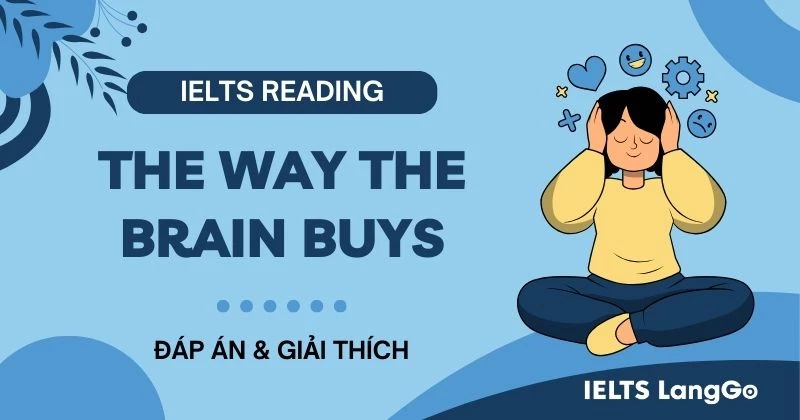
Bài đọc về chủ đề Making money, spending money: The way the brain buys hôm nay sẽ giúp bạn hiểu rõ hơn về những hành động, những thói quen khi đi siêu thị mà chúng ta thường có.
Quan trọng là đề bài này giúp bạn có thể luyện tập được 3 dạng bài rất hay gặp trong phần thi Reading là Labeling a diagram, True/False/Not Given và Flow-chart completion.
Reading Passage:
| The way the brain buys Supermarkets take great care over the way the goods they sell are arranged. This is because they know a lot about how to persuade people to buy things. When you enter a supermarket, it takes some time for the mind to get into a shopping mode. This is why the area immediately inside the entrance of a supermarket is known as the ‘decompression zone’. People need to slow down and take stock of the surroundings, even if they are regulars. Supermarkets do not expect to sell much here, so it tends to be used more for promotion. So the large items piled up here are designed to suggest that there are bargains further inside the store, and shoppers are not necessarily expected to buy them. Walmart, the world’s biggest retailer, famously employs ‘greeters’ at the entrance to its stores. A friendly welcome is said to cut shoplifting. It is harder to steal from nice people. Immediately to the left in many supermarkets is a ‘chill zone’, where customers can enjoy browsing magazines, books and DVDs. This is intended to tempt unplanned purchases and slow customers down. But people who just want to do their shopping quickly will keep walking ahead, and the first thing they come to is the fresh fruit and vegetables section. However, for shoppers, this makes no sense. Fruit and vegetables can be easily damaged, so they should be bought at the end, not the beginning, of a shopping trip. But psychology is at work here: selecting these items makes people feel good, so they feel less guilty about reaching for less healthy food later on. Shoppers already know that everyday items, like milk, are invariably placed towards the back of a store to provide more opportunity to tempt customers to buy things which are not on their shopping list. This is why pharmacies are also generally at the back. But supermarkets know shoppers know this, so they use other tricks, like placing popular items halfway along a section so that people have to walk all along the aisle looking for them. The idea is to boost ‘dwell time’: the length of time people spend in a store. Having walked to the end of the fruit-and-vegetable aisle, shoppers arrive at counters of prepared food, the fishmonger, the butcher and the deli. Then there is the in-store bakery, which can be smelt before it is seen. Even small supermarkets now use in-store bakeries. Mostly these bake pre-prepared items and frozen ingredients which have been delivered to the supermarket previously, and their numbers have increased, even though central bakeries that deliver to a number of stores are much more efficient. They do it for the smell of freshly baked bread, which arouses people’s appetites and thus encourages them to purchase not just bread but also other food, including ready meals. Retailers and producers talk a lot about the ‘moment of truth’. This is not a philosophical idea, but the point when people standing in the aisle decide to buy something and reach to get it. At the instant coffee section, for example, branded products from the big producers are arranged at eye level while cheaper ones are lower down, along with the supermarket’s own label products. But shelf positioning is fiercely fought over, not just by those trying to sell goods, but also by those arguing over how best to manipulate shoppers. While many stores reckon eye level is the top spot, some think a little higher is better. Others think goods displayed at the end of aisles sell the most because they have the greatest visibility. To be on the right-hand side of an eye-level selection is often considered the very best place, because most people are right-handed and most people’s eyes drift rightwards. Some supermarkets reserve that for their most expensive own-label goods. Scott Bearse, a retail expert with Deloitte Consulting in Boston, Massachusetts, has led projects observing and questioning tens of thousands of customers about how they feel about shopping. People say they leave shops empty- handed more often because they are ‘unable to decide’ than because prices are too high, says Mr Bearse. Getting customers to try something is one of the best ways of getting them to buy, adds Mr Bearse. Deloitte found that customers who use fitting rooms in order to try on clothes buy the product they are considering at a rate of 8% compared with 58% for those that do not do so. Often a customer struggling to decide which of two items is best ends up not buying either. In order to avoid a situation where a customer decides not to buy either product, a third ‘decoy’ item, which is not quite as good as the other two, is placed beside them to make the choice easier and more pleasurable. Happier customers are more likely to buy. |
Questions 1-4
Label the diagram below.
Choose NO MORE THAN THREE WORDS from the passage for each answer.
Layout of typical supermarket
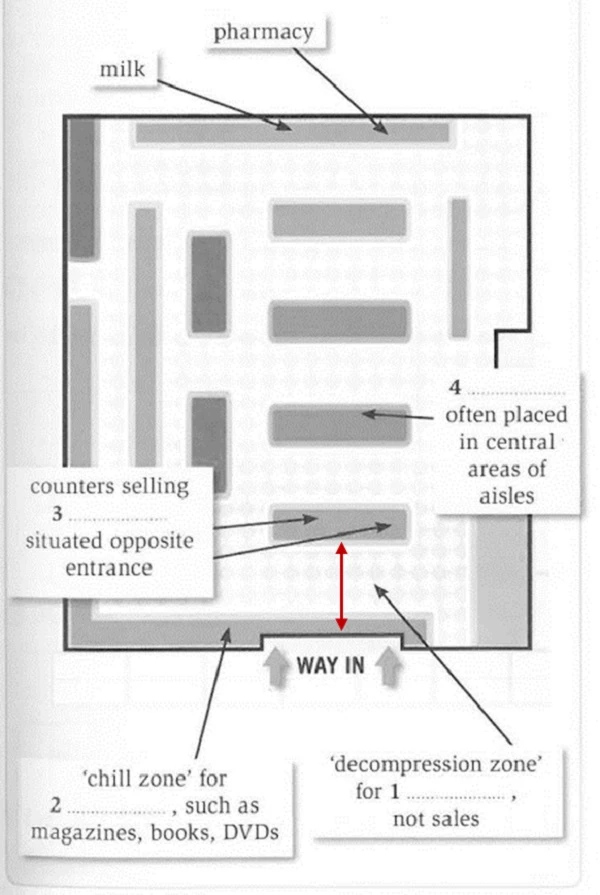
Questions 5-10: Do the following statements agree with the information given in the reading passage?
Write
TRUE if the statement agrees with the information
FALSE if the statement contradicts the information
NOT GIVEN if there is no information on this
Do the following statements agree with the information given in the reading passage?
5. The ‘greeters’ at Walmart increase sales.
6. People feel better about their shopping if they buy fruit and vegetables before they buy other food.
7. In-store bakeries produce a wider range of products than central bakeries.
8. Supermarkets find right-handed people easier to persuade than left-handed people.
9. The most frequent reason for leaving shops without buying something is price.
10. ‘Decoy’ items are products which the store expects customers to choose.
Questions 11-13: Complete the flowchart below
Choose NO MORE THAN TWO WORDS from the passage for each answer.
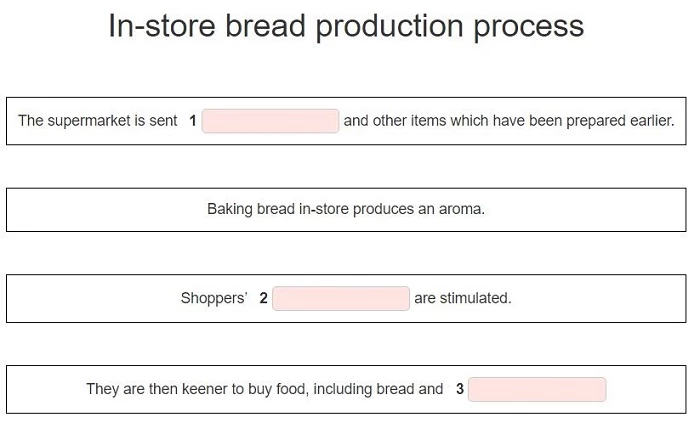
Bài đọc chủ đề Making money, spending money: The way the brain buys trên kiểm tra kỹ năng của bạn với 3 dạng bài trong IELTS Reading, bao gồm:
Dưới đây là một số lưu ý quan trọng các bạn cần nắm được khi làm 3 dạng bài này
Xem thêm: Cách làm dạng bài Labeling a diagram trong IELTS Reading
Xem thêm: Cách làm dạng bài True/False/Not Given IELTS chuẩn nhất
Xem thêm: Hướng dẫn làm dạng Sentence completion IELTS Reading
Sau khi hoàn thành 13 câu hỏi của bài đọc The way the brain buys, các bạn hãy tự đối chiếu với đáp án xem mình đã làm chính xác chưa nhé.

Questions 1-4
1. promotion
Dẫn chứng (Đoạn 1): "This is why the area immediately inside the entrance of a supermarket is known as the ‘decompression zone’. People need to slow down and take stock of the surroundings, even if they are regulars. Supermarkets do not expect to sell much here, so it tends to be used more for promotion
2. unplanned purchases
Dẫn chứng (Đoạn 2): “Immediately to the left in many supermarkets is a ‘chill zone’, where customers can enjoy browsing magazines, books and DVDs. This is intended to tempt unplanned purchases and slow customers down.”
3. fruit and vegetables
Dẫn chứng (Đoạn 2): “But people who just want to do their shopping quickly will keep walking ahead, and the first thing they come to is the fresh fruit and vegetables section.”
4. popular items
Dẫn chứng (Đoạn 3): “But supermarkets know shoppers know this, so they use other tricks, like placing popular items halfway along a section so that people have to walk all along the aisle looking for them.”
Questions 5-10
5. NOT GIVEN
Giải thích: Đoạn 1 bài đọc chỉ đề cập “Walmart, the world’s biggest retailer, famously employs ‘greeters’ at the entrance to its stores. A friendly welcome is said to cut shoplifting” => nghĩa là các Greeters chỉ để giảm tình trạng trộm cắp vặt nhưng không nói về tác động đến doanh số bán hàng.
6. TRUE
Giải thích: Đoạn 2 có nhắc đến ý này "selecting these items makes people feel good, so they feel less guilty about reaching for less healthy food later on." (Mua rau củ quả trước khiến người mua cảm thấy tốt hơn và ít cảm thấy tội lỗi khi mua đồ ăn kém lành mạnh sau đó.)
7. NOT GIVEN
Giải thích: Đoạn 4 "Mostly these bake pre-prepared items and frozen ingredients which have been delivered to the supermarket previously, and their numbers have increased, even though central bakeries that deliver to a number of stores are much more efficient."
=> Như vậy chỉ có thông tin: Lò bánh trong siêu thị chủ yếu nướng các sản phẩm được chuẩn bị sẵn và nguyên liệu đông lạnh và lò bánh trung tâm hiệu quả hơn. Không so sánh sự đa dạng về chủng loại sản phẩm giữa lò bánh trong siêu thị và lò bánh trung tâm.
8. NOT GIVEN
Giải thích: Đoạn 6 đề cập “To be on the right-hand side of an eye-level selection is often considered the very best place, because most people are right-handed and most people’s eyes drift rightwards.”
=> Chỉ đề cập đến việc đặt hàng bên phải vì phần lớn người mua hàng thuận tay phải, không so sánh khả năng thuyết phục giữa người thuận tay phải và trái.
9. FALSE
Giải thích: Đoạn 7 có thông tin "People say they leave shops empty-handed more often because they are 'unable to decide' than because prices are too high"
=> Nguyên nhân phổ biến nhất khiến người mua không mua hàng là "không thể quyết định" chứ không phải vì giá cao.
10. FALSE
Giải thích: Đoạn 8 có đề cập "decoy' item, which is not quite as good as the other two, is placed beside them to make the choice easier and more pleasurable"
=> Sản phẩm "mồi" được đặt để giúp việc lựa chọn dễ dàng hơn, không phải để khách hàng chọn mua.
Questions 11-13
11. frozen ingredients
Dẫn chứng: "Mostly these bake pre-prepared items and frozen ingredients which have been delivered to the supermarket previously" (Đoạn 4)
12. appetites
Dẫn chứng: "They do it for the smell of freshly baked bread, which arouses people’s appetites" (Đoạn 4)
13. ready meals
Dẫn chứng: “encourages them to purchase not just bread but also other food, including ready meals.” (Đoạn 4)
IELTS LangGo vừa cùng bạn luyện IELTS Reading chủ đề Making money, spending money với bài đọc The way the brain buys.
Hy vọng rằng những lưu ý khi làm bài kèm đáp án và giải thích chi tiết sẽ giúp bạn cải thiện kỹ năng làm bài và làm chính xác hơn khi gặp dạng bài Reading tương tự.

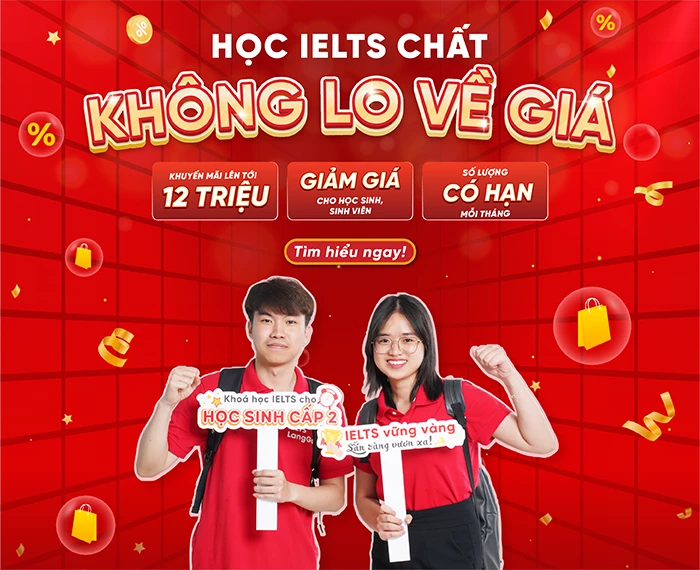
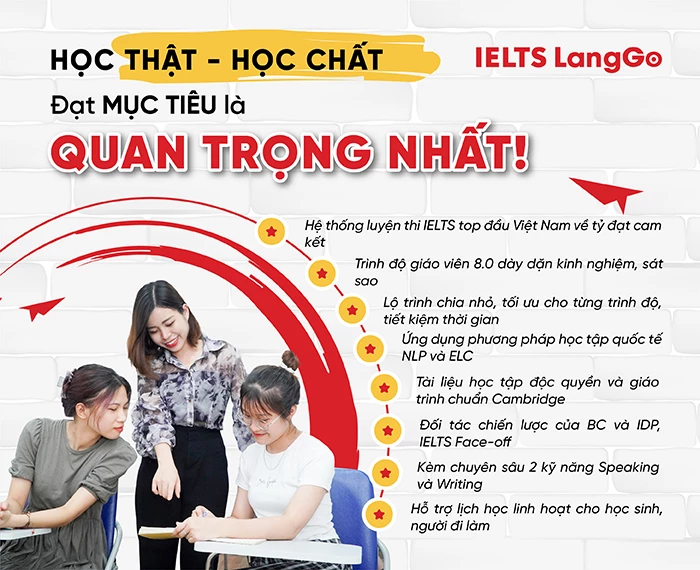
ĐẶT LỊCH TƯ VẤN MIỄN PHÍ LỘ TRÌNH Săn ƯU ĐÃI lên tới 12.000.000đ